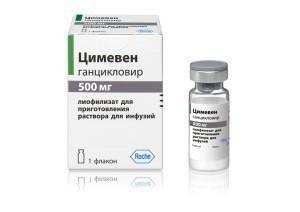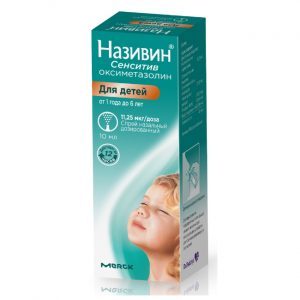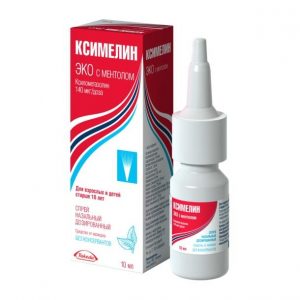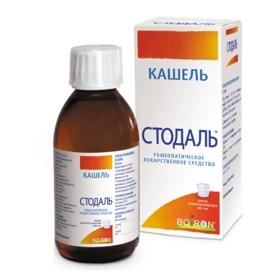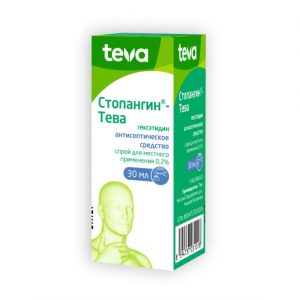Description
Release form
Lyophilisate for preparation of solution for infusions.
Packing
1 fl.
Pharmacological action
Cymeven is an antiviral agent. Ganciclovir is a synthetic analogue of 2′-deoxyguanosine, which inhibits the multiplication of herpes viruses in vitro and in vivo. Ganciclovir-sensitive viruses include human cytomegalovirus (h-CMV), herpes simplex viruses -1 and -2 (Herpes simplex 1 and 2), human herpes virus type 6, 7 and 8 (HHV-6, HHV-7, HHV-8), Epstein-Barr virus (EBV), chickenpox virus (Varicella / zoster) and hepatitis B virus. Clinical studies have been limited to evaluating the effectiveness of the drug in patients infected with cytomegalovirus.
In CMV-infected cells, ganciclovir is first phosphorylated by the action of a viral protein kinase to form ganciclovir monophosphate. Further phosphorylation occurs under the action of several cellular kinases, resulting in the formation of ganciclovir triphosphate, which then undergoes slow intracellular metabolism. This metabolism has been shown to occur in cells infected with human CMV and herpes simplex virus, after the disappearance of ganciclovir from the extracellular fluid, the intracellular half-life of the drug is 18 and 6-24 hours, respectively. Since the phosphorylation of ganciclovir is more dependent on the action of the viral kinase, it occurs predominantly in infected cells.
The virologostatic effect of ganciclovir is due to the suppression of viral DNA synthesis by: (1) competitive inhibition of the incorporation of deoxyguanosine triphosphate into DNA under the influence of DNA polymerase (2) incorporation of ganciclovir triphosphate into viral DNA, leading to termination of the extension of the viral DNA or its very limited extension. A typical CMV antiviral IC50, determined in vitro, is in the range of 0.14 μM (0.04 μg / ml) to 14 μM (3.5 μg / ml).
Contraindications
Hypersensitivity to Cymevene, valganciclovir, or any other component of the drug.
Due to the similarity of the chemical structure of Cymeven and acyclovir and valacyclovir, cross-hypersensitivity reactions are possible between these drugs.
The absolute neutrophil count is less than 500 cells in 1 l, or the platelet count is less than 25,000 cells in 1 l, or the hemoglobin level is less than 8 g / dl.
Children under 12 years old.
Use during pregnancy and lactation
During treatment with ganciclovir, women of childbearing age should be advised to use reliable methods of contraception. Men are recommended to use the barrier method of contraception during treatment and at least 90 days after its completion.
In animal studies teratogenicity of the drug was revealed. The safety of ganciclovir during pregnancy in humans has not been established. Prescribing the drug to pregnant women should be avoided unless the potential beneficial effect for the mother does not exceed the possible risk to the fetus.
Peri- and postnatal development after exposure to ganciclovir has not been studied, but it cannot be ruled out that ganciclovir may be excreted in milk and cause serious adverse reactions in the infant. Consequently, a decision to discontinue the drug or to stop breastfeeding should be made taking into account the potential positive effect of ganciclovir for a nursing mother.
Special instructions
Ganciclovir has a potential teratogenic and carcinogenic effect and may cause congenital malformations and malignant neoplasms. Ganciclovir may temporarily or permanently inhibit spermatogenesis (see Pregnancy and Side Effects).
Cases of severe leukopenia, neutropenia, anemia, thrombocytopenia, pancytopenia, myelosuppression, and aplastic anemia have been observed in patients taking ganciclovir. Ganciclovir treatment should not be started if the absolute number of neutrophils is less than 500 cells in 1 Ñl, or platelet count less than 25,000 cells in 1 Ñl, or hemoglobin level less than 8 g / dl (see Special dosage instructions and Adverse effects).
During treatment, it is recommended to monitor the expanded blood count, including platelet count. In patients with severe leukopenia, neutropenia, anemia and / or thrombocytopenia, it is recommended that hematopoietic growth factors be treated and / or temporarily discontinue therapy with the drug.
In case of impaired renal function, it is recommended to adjust the dose of the drug depending on the creatinine clearance.
Seizures are described in patients taking imipenem / cilastatin and ganciclovir, therefore ganciclovir should not be given concomitantly with imipenem / cilastatin, unless the potential benefits of therapy exceed the possible risk (see Drug Interactions).
Both ganciclovir and zidovudine can cause neutropenia and anemia, so some patients may not tolerate the simultaneous use of these drugs in full doses (see Drug Interactions).
While taking ganciclovir, plasma concentrations of didanosine may increase, so such patients should be carefully monitored for didanosine toxicity phenomena (see Drug Interactions). The simultaneous administration of ganciclovir and drugs with myelosuppressive or nephrotoxic effects can lead to the development of additive toxicity.
Composition of
One vial of the preparation contains:
ganciclovir 500 mg (as ganciclovir sodium salt).
Dosage and administration
Standard dosage for the treatment of CMV retinitis
Initial therapy: iv infusion at a dose of 5 mg / kg for 1 hour, every 12 hours (10 mg / kg / day) for 14-21 days (for patients with normal renal function).
Maintenance therapy: 5 mg / kg by intravenous infusion for 1 hour, daily for 7 days a week, or 6 mg / kg of body weight daily for 5 days a week.
Standard dosage for prophylaxis in patients after transplantation
Initial therapy: iv infusion at a dose of 5 mg / kg for 1 hour, every 12 hours, for 7-14 days (for patients with normal renal function).
Maintenance Therapy: 5 mg / kg by intravenous infusion for 1 hour, daily for 7 days a week or 6 mg / kg of body weight daily for 5 days a week.
Side effects of
HIV-infected
patients Clinical adverse events observed in 2% of patients receiving intravenous ganciclovir, regardless of their causal relationship with the drug and severity:
from the blood and lymphatic systems: neutropenia, anemia, thrombocytopenia, leukopenia,
lymphadenopathy from the digestive system: diarrhea, abdominal pain, dysphagia, esophageal candidiasis
organism as a whole: fever, candidiasis, infections at the injection site, sepsis, secondary sepsis, anorexia, various mycobacteriosis av mycobact localization, chest pain,
bacteremia from the central and peripheral nervous system: hypoesthesia,
anxiety state from the side of the skin and its appendages:
itching from the respiratory system: cough, pneumocystis pneumonia, cough with sputum, oynye phenomena in the paranasal sinuses
laboratory parameters: increased activity of alkaline phosphatase in the blood, increased creatinine in the blood, neutropenia, anemia, thrombocytopenia, increased serum creatinine
from the musculoskeletal system: arthralgia.
Patients after transplantation
Clinical adverse events observed in? 5% of patients who received ganciclovir intravenously for the treatment or prevention of manifest CMV infection after bone marrow transplantation, regardless of their causal relationship with the drug and severity:
from the hemopoietic organs: pancytopenia, leukopenia
body as a whole: mucosal lesions, fever, digestion, sepsis, anorexia, digestion of the
face from the digestive system: diarrhea, dyspepsia
laboratory parameters: increased creatinine, hepatic transaminase activity, hypomagnesemia, hypocalcemia , hypokalemia
from the nervous system: headache, tremor, confusion
from the skin and its appendages: exfoliative
dermatitis from the respiratory system: rhinitis, dyspnea
from the cardiovascular system: tachycardia, arterial hypotension
from the genitourinary tract: hematuria
sensory organs: hemorrhage in the eye
musculoskeletal system: myalgia.
Clinical adverse events observed in? 5% of patients who received ganciclovir intravenously after a heart transplant, regardless of causation or severity:
Organism as a whole: infection (18%).
Metabolic and nutritional disorders: edema (9%).
Central and peripheral nervous system: headache (18%), confusion (5%), peripheral neuropathy (7%).
Respiratory: pleural effusion (5%).
Cardiovascular system: arterial hypertension (20%).
Genitourinary tract: impaired renal function (14%), renal failure (12%).
Due to the high bioavailability of intravenously administered ganciclovir, it cannot be ruled out that intravenous administration of the drug may result in the same adverse effects as in studies with oral ganciclovir.
To fully characterize the safety profile of intravenously administered ganciclovir, the following are relevant adverse events that were detected more frequently with oral administration of ganciclovir in HIV-infected or patients after organ transplantation, regardless of their severity and causal relationship with the drug. Some adverse effects when taking ganciclovir orally can be associated with this particular method of taking the drug.
Blood system and lymphatic system: leukocytosis.
Digestive organs: constipation, cholangitis, flatulence, vomiting.
Organism as a whole: ascites, asthenia, bleeding, bacterial, fungal and viral infections, malaise.
Cardiovascular system: vasodilation (lowering blood pressure, redness of the skin of the face).
Central and peripheral nervous system: depression, dizziness, insomnia.
Liver and biliary tract: cholestatic jaundice.
Skin: increased sweating.
Sensory organs: amblyopia, taste disturbances.
Metabolic and nutritional disorders: diabetes, hyponatremia, hypoproteinemia, weight loss.
Other adverse events
The following are significant adverse events that were not indicated above, as did not meet the inclusion criteria (less than 2%).
blood system and lymphatic system: aplastic anemia, myelosuppression, eosinophilia.
Digestive organs: gastrointestinal bleeding, belching, fecal incontinence, ulcerative stomatitis, pancreatitis, glossitis.
Infections: episodes of infections caused by depression of the bone marrow and immune system (local and systemic infections and sepsis).
Bleeding: Potentially life-threatening bleeding due to thrombocytopenia.
Organism as a whole: cachexia, dehydration, weakness, thrombosis at the injection site, abscess at the injection site, edema at the injection site, pain at the injection site, hemorrhage at the injection site, malaise, photosensitivity reactions.
Central and peripheral nervous system: agitation, convulsions, hallucinations, psychosis, impaired thinking, nightmares, ataxia, coma, dry mouth, euphoria, nervousness, drowsiness.
Skin and its appendages: dermatitis, acne, alopecia, herpes simplex, urticaria.
Sensory organs: retinal detachment, visual impairment, blindness, hearing loss, eyeball pain, glaucoma, vitreous destruction.
Laboratory indicators: increased activity of creatine phosphokinase and lactate dehydrogenase in the blood, hypoglycemia.
Genitourinary tract: rapid urination.
Cardiovascular system: arrhythmias (including ventricular), deep vein thrombophlebitis, migraine, phlebitis.
Musculoskeletal system: myasthenic syndrome.
Overdose
In overdose, in some cases, no undesirable effects occurred. In most patients, one or more of the following adverse events were noted:
Hematologic toxicity: pancytopenia, myelosuppression, bone marrow aplasia, leukopenia, neutropenia, granulocytopenia.
Hepatotoxicity: hepatitis, impaired liver function.
Nephrotoxicity: increase in hematuria in a patient with pre-existing kidney damage, acute renal failure, increased creatinine.
Gastrointestinal toxicity: abdominal pain, diarrhea, vomiting.
Neurotoxicity: generalized tremor, convulsions.
In addition, one adult patient was intravitrally administered an excess volume of ganciclovir solution for intravenous administration, followed by temporary visual loss and occlusion of the central retinal artery due to an increase in intraocular pressure caused by the injected volume.
Hemodialysis and hydration can be used to reduce plasma levels of ganciclovir with oral overdose of Cimeven.
Storage conditions
Do not store above 30 ° C.
Shelf life
3 years.
Deystvuyushtee substance
Ganciclovir
Terms and conditions
prescription
Dosage form
solution for infusion
Indications
Indications
Herpes
F. Hoffmann-La Roche Ltd, Switzerland
